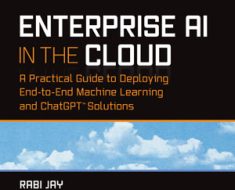
English | MP4 | AVC 1280×720 | AAC 44KHz 2ch | 132 lectures (15h 52m) | 8.19 GB
Learn Rust Whilst Taking ChatGPT to the Extreme In Creating an Automated GPT that Builds and Tests Code for You
Develop a an automated ChatGPT agent which not only writes code, but tests and re-write code for you. In fact, you can request your agent to do just about anything.
By going through this course, you will not only learn and master Rust from A-Z, but you will also have extensive knowledge in how to build your very own AutoGPT.
The name of the AutoGPT we build together will be Auto-Gippity.
Auto-Gippity will simply be given a task, which it will break down and delegate to other agents to complete. Each agent will be responsible for testing its own output.
Our test piece will be to build an agent that writes a web server given a template. It will write the code in Rust. Not only that, but we will write the agent, that writes Rust code…in Rust. Fantastic. What a time to be a developer.
AutoGPTs will only continue to become extremely relevant and highly sought after and combining these with the worlds favourite programming language, Rust, means that we can build an application which is blazingly fast, memory-safe, modern and robust.
Right now, there is a window of opportunity to learn this fantastic and uncommon technology before it takes over in software engineering.
Just think, you could build an AutoGPT that say, develops full stack SAAS websites end-to-end. With technologies like GPT-4 and soon beyond, such agents will only continue to improve in their performance.
Companies are looking for developers who can build such tools and SAAS startups have a window to be first. If you are curious as to how you can connect new AI technologies to change the world then THIS is the course for you.
You will learn:
- How to work with the Open AI API and the GPT-4 API using Rust
- How to master rust from A to Z, progressing from beginner, to intermediate, to advanced and beyond
- How to build AI functions (special functions that extract a desired response from large-language-models)
- How to develop a web server template (including an introduction to web servers) using Actix Web
- How to build an Automated GPT agent (Auto-Gippity) which writes code, that executes and tests code. If the code is wrong, it will simply re-write it and test again
Table of Contents
Introduction
1 What We Are Building
2 Programming Experience Required
3 About Your Instructor
4 Discord and Q&A
5 Getting Access to GPT-4
6 AI Functions and LLM Limitations
7 Course Structure Overview
8 IMPORTANT RESOURCES
Rust Crash Course – Learning the Rust Environment
9 Rust installation – Quick Walkthrough
10 Rust Installation – Windows Docs
11 About Rustup
12 Rustup Tool Manager Docs
13 Preparing Visual Studio Code
14 Cargo New – Your First Rust Project
15 Your First Rust Function
16 A Brief Programming Language Comparison
17 Structuring Project Modules – Brief Introduction
18 Unit Testing with Cargo
19 Create Docs with Cargo
20 Creating a Rust Library
21 Dead Code and Unused Variables
Rust Crash Course – Types and Memory Management
22 Must-Know Resources
23 Rust vs Other Languages Revisited
24 Integer Types
25 Data Type Cheatsheet
26 Stack vs Heap Intro
27 Stack Deep Dive
28 Stack vs Heap Walkthrough
29 String Literals and Static (Read-Only) Memory
30 Ownership and Borrowing – Immutable References
31 Ownership and Borrowing – Mutable References
32 Ownership and Borrowing – Dereferencing
33 About Scope
Rust Crash Course – Basics
34 Intro – Create Project
35 Fixed Size Variables
36 Dynamic Sized Variables
37 Basic Collections
38 Closures
39 Number Literals and Raw Strings
40 Working Low Level with Binary
41 Rust Std Library
Rust Crash Course – Intermediate
42 Intro – Create Module
43 Enums – Your First Enum
44 Enums – Result Enum with Generics Introduction
45 Enums – Option Enum with Some or None
46 Rusts Result and Option
47 Structs – Your First Struct
48 Structs – Using Type Impl
49 Traits Introduction
50 Polymorphism with Traits and Generics
51 Lifetimes – Introduction
52 Lifetimes – Generics and Structs
53 Pattern Matching – Integer, Option and Result
54 Pattern Matching – Mixed Data Enum
55 Pattern Matching – Match Guards and Structs
56 Your First Async API Call
57 Handling Errors
58 Collections Revisited – HashMaps and HashSets
59 Project Cleanup
Rust Crash Course – Advanced
60 Declarative Macros – Introduction
61 Declarative Macros – With Repetitions
62 Declarative Macros – Note on Module Exporting
63 Procedural Macros (Theory) – Introduction to Derive
64 Procedural Macros (Theory) – Function Like Macro
65 Procedural Macros (Theory) – Attribute Like Macro
66 Procedural Macros (Practice) – Building an AI Function
67 Smart Pointers – Box
68 Smart Pointers – Reference Counting with RefCell
69 Smart Pointers – Reference Counting with Weak
70 Rust Concurrency with Mutex and Arc
71 Publish Packages to Crates
Build Web Server Template – First Project
72 Theory – Introduction to Web Servers and Actix Web
73 Theory – Actix Web REST API Docs Walkthrough
74 Project Setup
75 Struct Definitions
76 Database Implementation
77 Creating AppState with Mutex Provided Safety
78 Writing Our Initial Web Server
79 Testing Create Task Rest API Endpoint With Postman
80 Create and Test GET Task Request
81 Complete Task CRUD
82 User Registration and Login
83 Mutation Adjustment
84 Next Steps
Auto GPT Project – Supporting Functions
85 Supporting Functions – Section Introduction
86 Project Setup
87 User Interaction with Command Line
88 Extract API Keys
89 OpenAI Call – Key Provisions
90 OpenAI Call – Create Client
91 OpenAI Call – Test API Call
92 OpenAI Call – Error Handling
93 OpenAI Call – Completion
94 Extract AI Functions
95 Extend AI Function
96 Print Agent Activity to Command Line
97 AI Task Function
98 AI Task Function Decoded
99 API Endpoint Valid Check Function
100 File Read and Write Functions
Auto GPT Project – Create Agents
101 Create Agents – Section Introduction
102 Basic Agent – Create Basic Agent
103 Managing Agent – FactSheet Struct
104 Managing Agent – Special Functions Trait
105 Solutions Architect – Call Project Scope
106 Solutions Architect – Call External Urls
107 Solutions Architect – Handle Discovery State
108 Solutions Architect – Write Test for Checking Urls
109 Solutions Agent – Full Agent Test
110 Managing Agent – Create New
111 Managing Agent – Execute Project Fn
112 Managing Agent – Initial Agent Test
113 Backend Developer – Write and Improve Code Fn
114 Backend Developer – Fix Code Bugs Fn
115 Backend Developer – Rest API Endpoints Fn
116 Backend Developer – Discovery and Working States
117 Backend Developer – Initial Agent Test
118 Backend Developer – Ensure AI Safety Human Check
119 Backend Developer – Write Automated Cargo Build
120 Backend Developer – Write Automated Cargo Run
121 Backend Developer – Write Automated Endpoint Testing
122 Backend Developer – Unit Testing Agents Unit Tests
123 Backend Developer – Testing Code Rewrites
Auto GPT Project – Finalise Agent Gippity
124 Performing First Complete Agent Test (External Url Based)
125 Performing First Test – Human Review
126 Performing Second Test (Tracking CRUD Based)
127 Performing Third Test (Hangman Game Build)
128 Performing Third Test – Human Review
129 Paper – Large Language Models as Tool Makers (Optional)
130 Further Reading (Optional)
131 Considerations on Overcoming Limitations
132 Next Steps
Download from free file storage




![From Optimal Observables to Machine Learning: an Effective-Field-Theory Analysis of $e^+e^- to W^+W^-$ at Future Lepton Colliders. (arXiv:2401.02474v1 [hep-ph]) From Optimal Observables to Machine Learning: an Effective-Field-Theory Analysis of $e^+e^- to W^+W^-$ at Future Lepton Colliders. (arXiv:2401.02474v1 [hep-ph])](https://aigumbo.com/wp-content/uploads/2023/12/arxiv-logo-fb-235x190.png)